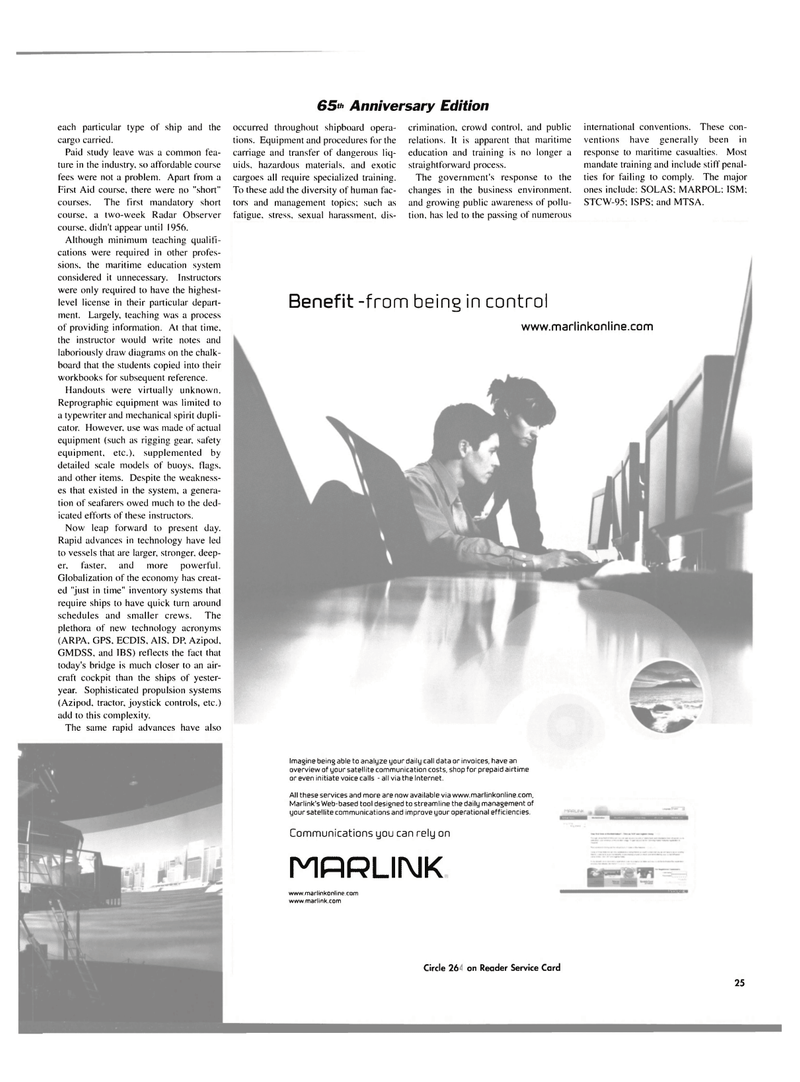
Page 25: of Maritime Reporter Magazine (August 2004)
65th Anniversary Edition
Read this page in Pdf, Flash or Html5 edition of August 2004 Maritime Reporter Magazine
65th Anniversary Edition each particular type of ship and the cargo carried.
Paid study leave was a common fea- ture in the industry, so affordable course fees were not a problem. Apart from a
First Aid course, there were no "short" courses. The first mandatory short course, a two-week Radar Observer course, didn't appear until 1956.
Although minimum teaching qualifi- cations were required in other profes- sions, the maritime education system considered it unnecessary. Instructors were only required to have the highest- level license in their particular depart- ment. Largely, teaching was a process of providing information. At that time, the instructor would write notes and laboriously draw diagrams on the chalk- board that the students copied into their workbooks for subsequent reference.
Handouts were virtually unknown.
Reprographic equipment was limited to a typewriter and mechanical spirit dupli- cator. However, use was made of actual equipment (such as rigging gear, safety equipment, etc.). supplemented by detailed scale models of buoys, flags, and other items. Despite the weakness- es that existed in the system, a genera- tion of seafarers owed much to the ded- icated efforts of these instructors.
Now leap forward to present day.
Rapid advances in technology have led to vessels that are larger, stronger, deep- er, faster, and more powerful.
Globalization of the economy has creat- ed "just in time" inventory systems that require ships to have quick turn around schedules and smaller crews. The plethora of new technology acronyms (ARPA, GPS, ECDIS, AIS, DP, Azipod,
GMDSS, and IBS) reflects the fact that today's bridge is much closer to an air- craft cockpit than the ships of yester- year. Sophisticated propulsion systems (Azipod, tractor, joystick controls, etc.) add to this complexity.
The same rapid advances have also occurred throughout shipboard opera- tions. Equipment and procedures for the carriage and transfer of dangerous liq- uids. hazardous materials, and exotic cargoes all require specialized training.
To these add the diversity of human fac- tors and management topics; such as fatigue, stress, sexual harassment, dis- crimination, crowd control, and public relations. It is apparent that maritime education and training is no longer a straightforward process.
The government's response to the changes in the business environment, and growing public awareness of pollu- tion, has led to the passing of numerous international conventions. These con- ventions have generally been in response to maritime casualties. Most mandate training and include stiff penal- ties for failing to comply. The major ones include: SOLAS; MARPOL: ISM:
STCW-95; ISPS; and MTSA.
Imagine being able to analyze your daily call data or invoices, have an overview of your satellite communication costs, shop for prepaid airtime or even initiate voice calls - all via the Internet.
All these services and more are now available via www.marlinkonline.com,
Marlink's Web-based tool designed to streamline the daily management of your satellite communications and improve your operational efficiencies.
Communications you can rely on
NRRLINK www.marlinkonline.com www.marlink.com
Circle 260 on Reader Service Card
Benefit -from being in control www.marlinkonline.com 25

 24
24

 26
26
